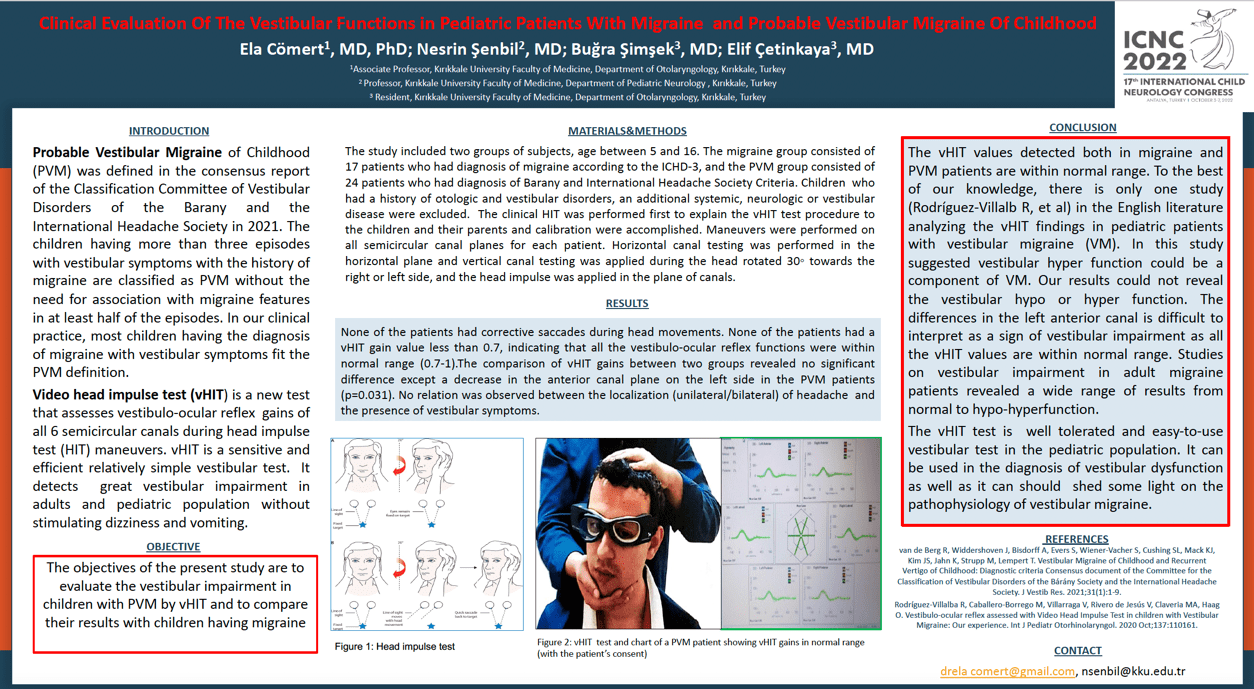Clinical Evaluation Of The Vestibular Functions In Pediatric Patients With Migraine And Probable Vestibular Migraine Of Childhood
Ela Cömert, Nesrin Şenbil, Buğra Şimşek, Elif Çetinkaya
Objective: The objectives of the present study are to evaluate the vestibular impairment in children with probable vestibular migraine of childhood by using video head impulse test (vHIT) and to compare their results with children having migraine. Methods: The study population consisted of 41 pediatric patients diagnosed as migraine according to the International Classification of Headache Disorders, 3rd edition. The patient group consisted of 17 patients with migraine and 24 patients with probable vestibular migraine of childhood. The Classification of Vestibular Disorders of the Barany Society and the International Headache Society was used for the diagnosis of probable vestibular migraine of childhood. Patients having any otologic and vestibular disorders were excluded. vHIT test parameters were compared between these two groups of patients. Results: None of the patients had a vHIT gain value less than 0.7, indicating that all the vestibule-ocular reflex functions were within normal range (0.7-1). In addition, none of the patients had corrective saccades during head movements. The comparison of vHIT gains between two groups revealed no significant difference except a decrease in the anterior canal plane on the left side (p=0.031). Conclusion: vHIT test is a diagnostic test in determining vestibular hypofunction. It evaluates the vestibule-ocular reflex gains of all 6 semicircular canals. The present study revealed comparable vHIT gains in all semicircular canals except left anterior plane in patients with migraine and probable vestibular migraine of childhood. Both groups do not have a great vestibular impairment that can be detected with vHIT test.
Keywords: migraine, vestibular migraine, video head impulse test, vestibular disorder
Ela Cömert
Turkey
Nesrin Şenbil
Turkey
Buğra Şimşek
Turkey
Elif Çetinkaya
Turkey
Objective: The objectives of the present study are to evaluate the vestibular impairment in children with probable vestibular migraine of childhood by using video head impulse test (vHIT) and to compare their results with children having migraine. Methods: The study population consisted of 41 pediatric patients diagnosed as migraine according to the International Classification of Headache Disorders, 3rd edition. The patient group consisted of 17 patients with migraine and 24 patients with probable vestibular migraine of childhood. The Classification of Vestibular Disorders of the Barany Society and the International Headache Society was used for the diagnosis of probable vestibular migraine of childhood. Patients having any otologic and vestibular disorders were excluded. vHIT test parameters were compared between these two groups of patients. Results: None of the patients had a vHIT gain value less than 0.7, indicating that all the vestibule-ocular reflex functions were within normal range (0.7-1). In addition, none of the patients had corrective saccades during head movements. The comparison of vHIT gains between two groups revealed no significant difference except a decrease in the anterior canal plane on the left side (p=0.031). Conclusion: vHIT test is a diagnostic test in determining vestibular hypofunction. It evaluates the vestibule-ocular reflex gains of all 6 semicircular canals. The present study revealed comparable vHIT gains in all semicircular canals except left anterior plane in patients with migraine and probable vestibular migraine of childhood. Both groups do not have a great vestibular impairment that can be detected with vHIT test.
Keywords: migraine, vestibular migraine, video head impulse test, vestibular disorder
Ela Cömert
Turkey
Nesrin Şenbil
Turkey
Buğra Şimşek
Turkey
Elif Çetinkaya
Turkey

Nesrin Şenbil
Turkey
Turkey